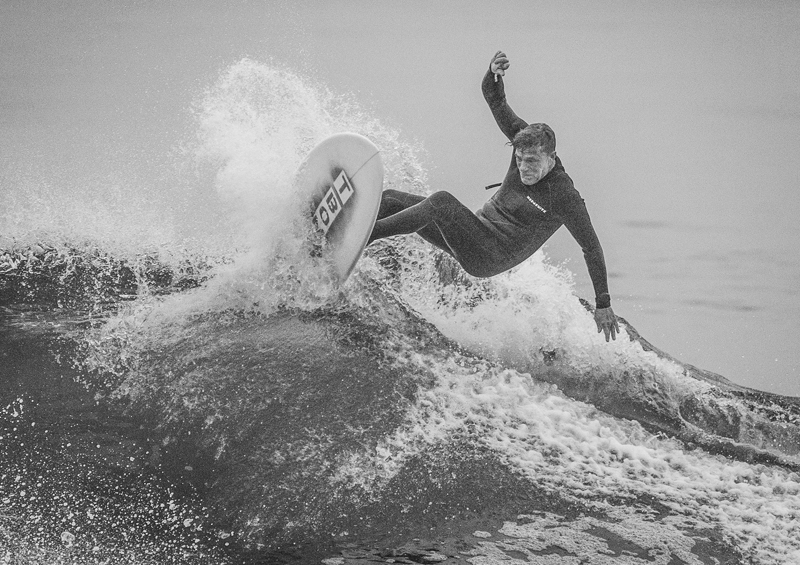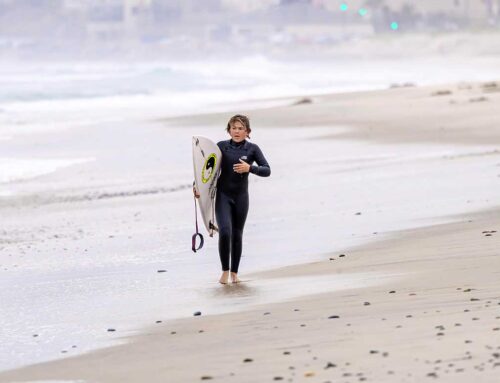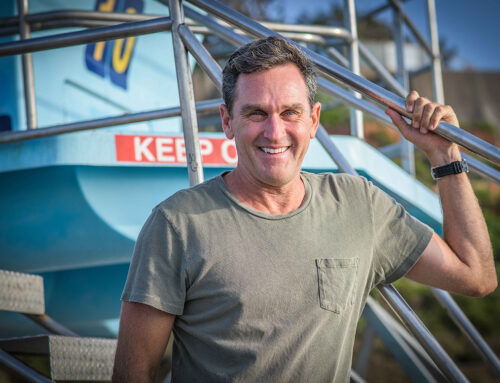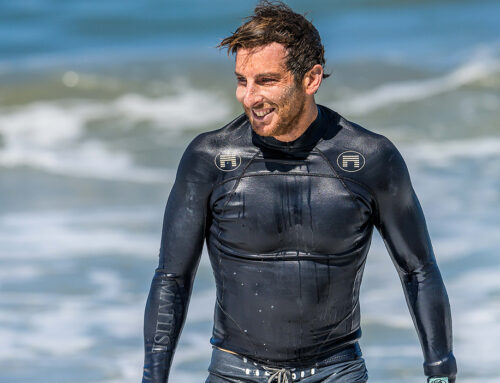Interviewed and photographed by Nicholas Paoni
If you’ve ever met Steve Sherman you would remember him. He’s big with a broad, easy smile and booming, contagious laugh. Did I mention his hats? He wears lots of them, and they top off his outgoing personality. Beneath it all, however, is an extremely talented photographer with amazing skills honed through years of practicing photo journalism.
Steve started out as a skater and worked as a Staff Photographer at Transworld Skateboarding. Next he transitioned to surfing and was a Photo Editor for Transworld Surf and then Surfing Magazine. He also was a professional photographer touring with the World Surf League.
Steve has photographed some of the most famous names in surfing. Unlike some others who have photographed them in the water or through a telephoto lens, Steve has done it up close and personal. In fact through the years it has been his ability to gain access to these super stars and document them through candid portraiture that has set his work apart from others in the competitive area of sports photography.
I met Steve at Seaside Reef, State Beach to talk about his love of skating, surfing and photography, and how he has turned these passions into a successful career behind the viewfinder.
N. Hi Steve, thanks for taking the time to chat with me about your amazing career. Unlike some other surfers and photographers in the industry you’re not originally from California. Where were you born and when did you come to California?
S. I was born in Elwood, Indiana in the Midwest, and I also lived in Indianapolis. When I was 11 my family moved to California. I lived out in Poway and in Rancho Bernardo where I did skateboarding. My mom and dad moved to Solana Beach, two years later in 1976. That’s when I started skateboarding professionally, and learned to surf. In Solana Beach I learned to surf at Pillbox. Since I skateboarded a lot I caught on pretty quickly.
N. When did photography come into your life and did you have any formal training?
S. When I was in seventh grade, at Earl Warren Middle School, I took a photography class with Ed Landfear. It was a rudimentary class, learning how to develop and print. I caught on pretty quickly and I did some photos. Then once I got to Torrey Pines High School, in ninth grade, I got recruited to be on the school newspaper. So from 10th grade on I had access to a dark room. I was learning journalism and I figured I had a good knack for it. That’s kind of what started it.
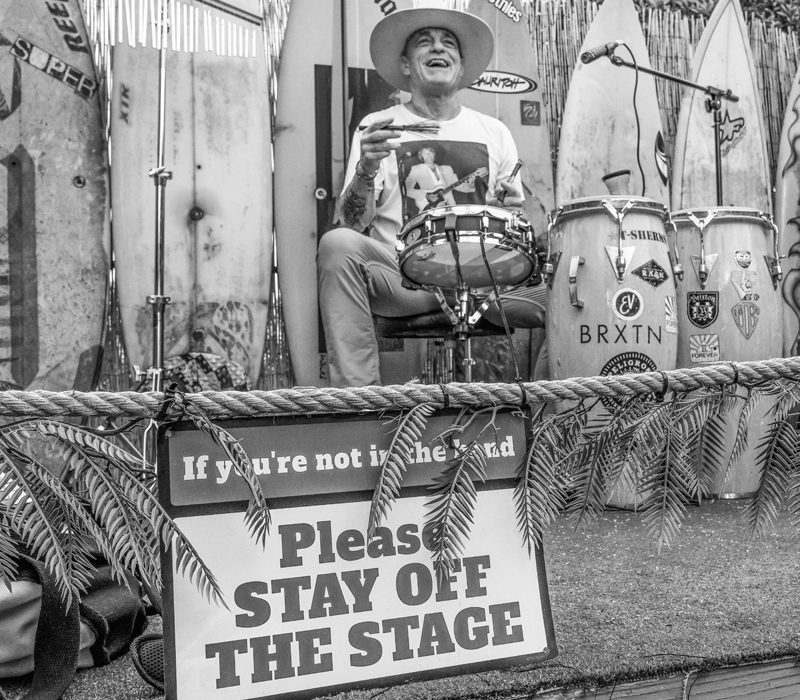
N. So you started out shooting skating and then you moved over to surfing.
S. Well, actually, I shot some skateboarding and then I did some art photos on my own. Then I met Grant Britain who I knew from the Del Mar skate Ranch. He was Photo Editor at Transworld Skateboarding, and he hired me in a late 80s to become a dark room tech. I was developing 40 rolls a day, wow, literally the whole magazine. I worked my way out of the dark room and into shooting. Then in ’99 they decide to do a surf magazine and then I graduate from being a staff photographer to a Photo Editor. I was making about $30,000 a year, but it was really cool cuz we built something up from scratch at Transworld Surf that no one had ever done. Our vision, me and Chris Cote, was to build a surfing magazine that looked like a skateboarding magazine. So I had a big influence on a lot of photographers, teaching them how to shoot photo journalism.
N. Unlike a lot of sports photographers you didn’t stop there. You’ve also done music photography. Tell me a little bit about your photography in the music industry
S. Music has always been my muse. I played in bands. I played percussion. I’ve always shot concerts. Then in 2006 I met Eddie Vedder through Kelly Slater. Once I met Eddie, it opened up a new world. He was my age and grew up around here and he knew some of the bands that I played in the 80s. I shot him a ton so he let me have access. One time he said to Rob Machado, “there’s just two photographers I even like, Danny Clinch and Sherm”. Danny Clinch is like the best rock photographer in the whole world. I thought that was a great compliment.
N. I think it’s fair to say that you’ve done a lot of clutch shooting. Can you take one or two instances and tell me when you really had to get the shot?
S. Kelly Slater, when he got his seventh world title. I followed him to Brazil and there was a bounty out for the shot. This is right before the digital age. Quicksilver was offering me $20,000 to get the shot. I’m shooting film so the moment came and I shot it all in 35mm. I didn’t know until I got home if I got the shot. I went to chrome and I looked at it and said “ah ha!”.
I have a good photo journalistic sense so that kind of pressure doesn’t really bother me. When you shoot weddings it’s the same thing, you gotta get the shot, and in contests you gotta get the shot. Sometimes you gotta make things happen or be aware of things happening. In the surfing world I’m known for getting a lot of clutch shots.
N. In order to accomplish what you have so far with your intimate portraits you had to sort of imbed yourself and really be accepted by that community. How were you able to do that with so many different sports personalities?
S. With the surfing, I met Taylor Steele. I went to him and said “hey I’m making this video called “Focus” and I want to get a photo of all the boys and shoot it like a band photo”, and he said “yes”. “ I’m living right down the street and I’ll tell you what, I’m gonna show up at your house at 2 o’clock with Kelly Slater, Donovan, Dory, Shane all these guys.” I’m thinking none of these guys will show up right? This is not going to happen, but I’m ready. Then 2 o’clock on the nose they show up. I shot them in the yard, and then we took them over to the car wash and shot them like a band photo. It came out really good, and from that point on I was the main man with those guys. I just became really good friends with all those guys, and that opened up a whole new world of shooting surfing kind of behind the scenes.
I had no interest in shooting surf action. I’m a surfer and I didn’t want the water shots. If the waves are good, I don’t want to sit on the beach shooting, I did that for a while, off and on, so this is my way of not having to shoot surf photography. Also I surfed with all those guys, I had a street cred as being a good surfer.
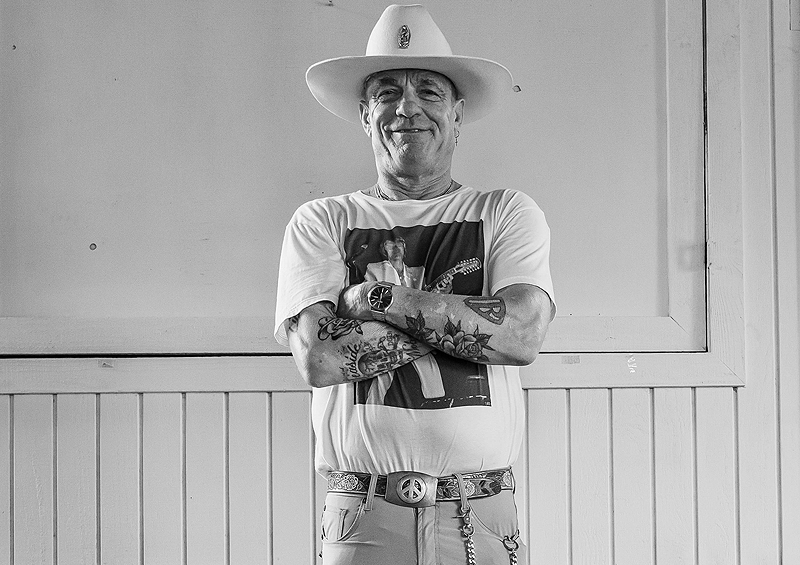
N. You’ve taken some real iconic shots. Can you tell me the backstory behind one of your favorites?
S. Well, one of them, the most famous, is a shot of Kelly Slater and Andy Irons from the North Shore in 2003. When I’m on the North Shore I go from house to house in the morning, get coffee and check in with everyone. I’m very lucky, I have a lot of friends and I’m welcome in every house. I’m at the Red Bull house and Andy is there and Mick Fanning was in the back corner, which I didn’t even know. So I get in there and they give me a cup of coffee. Andy is on the computer and he looks over and all of a sudden there’s a knock on the door. It’s Kelly and they are number one and two in the world at that point. Over the next 10 days the world title was going to go down. So Kelly is in a golf shirt walks in and and he says “is Damien here” and Andy says “Damien does’t live here”. So the house is all full of surfers, dead silent. Kelly was walking around the house and I just happened to have my camera with high speed black and white. He stands next to Andy and I shot 3 quick frames, click, click, click, and put my camera down. That shot became famous because everyone thought that Kelly was trying to psych out Andy. Kelly claimed he was looking for Damian because he was going to play golf with him, but you just never know cuz Kelly always has a sly way. He knows war and peace. So that photo became famous. It was a two page spread and that was the beginning of the war between those two. So every time I do my slide show people want to know about that photo more than any other photo.
N. You’ve also done some product shoots for companies. How does that kind of atmosphere, or set up, compare to your spontaneous and candid work that you do with portraits?
S. It’s just work. I’ve done a lot of catalogs in my life. I can hack away at product stuff, but I’m just not passionate about it. I’d rather shoot a wedding than do product stuff. I like shooting people and intimate moments. I really get off on that, and also I really like shooting family portraits at the beach. The older I get I still love it.
N. You’ve been doing art shows recently and some speaking engagements. Is that something you really enjoy or is that just part of the business?
S. I enjoy it. If you’d have told me 15 years ago that I’d be talking to people about my photos I would have said “no way”. I’m very shy, believe it or not, and so I started doing them and I started to get good at it. I figured out that if you make people laugh you’re already half way there. The last one I did was a show called “War and Peace” which was Kelly Slater and Andy Irons. I did all their photos and I talked about them. I did the Belly Up two year ago and it sold out. It was great and I just enjoy telling the stories and people seem to like the intimacy. So I had a bunch of photos on the wall to sell, and I sold some. But as soon as I was done talking people ran for the wall and I sold every one. So I think people enjoy a good photo with a story.
N. What’s your go to camera gear for your portrait work.
S. The Canon 5D Mark IV. I love that camera, great in low light. For focal length right now I have a 24-105mm that I really love. I have a 20 fixed that I really love, and a 70-200mm, and so those are my go to lenses. For processing I’m really good at making my digital look like film. I’m not a Photoshop geek at all. I treat my computer like a dark room. I don’t mask anything, I just adjust contrast and color.
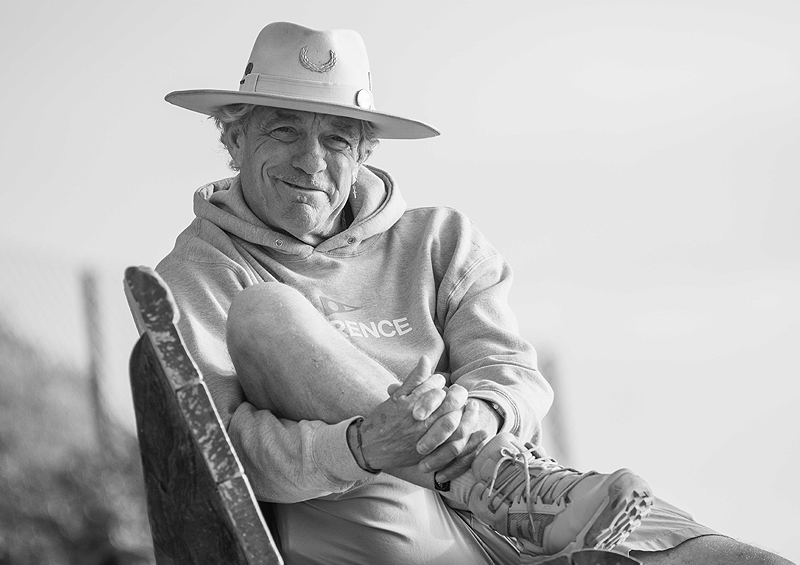
N. I happen to know that you are also a musician, a drummer. So what’s it like being on the other side of the performance rather than shooting performers?
S. I’ve played in bands since the 80’s. We had a band called “Broad Tree Loco, and we were really popular. We had 3 percussionists. I learned Latin percussion from guys down in San Diego. So Conga, Bongo, all Brazilian percussion. I know the Samba rhythm and the Latin rhythms so that’s what I do. Now I play with bands using a snare drum and brushes, kind of what Willy Nelson’s drummer does. It’s fun and I love playing music.
I toured with Donavon Frankenreiter 12 years ago in Europe for a month. I made a film about it, I shot photos, I played every night. That was an eye opener. Rock ’n’ role is my muse, I love it. I’ve also jammed with Luis Nelson, so I know I’m good if I can play with those guys.
N. Now you’ve had a career where you’ve travelled a lot, hung out with some of the most famous surfers, spent a lot of time on the road. I’m sure it’s been amazing but are there any regrets?
S. The only regret I have is missing a lot of time with my boys when they were young. because I was working for both magazines and traveling a lot. When I’m home, I’m home with them, but then I’d get a job working as a photo editor and I’d be traveling and working full time at a magazine, and that took a lot of time. I kind of miss those days now a little bit, but as I said that’s the only regret. And my wife has made a lot of sacrifices for me to be able to keep my dream alive. I’m just trying to keep the dream alive right now.
N. What advice do you have for the newcomers, people that admire what you’ve done. What can you tell them about how they can make it?
S. I’m very fortunate in that I’ve influenced a lot of young surf photographers. I always say to be original. I say learn all the rules and then learn to break them. There’s this famous teacher of mine, a graphic designer David Carson, and he’d always say “Sherm give me your beautiful mistakes, like a blurry photo”. Then I started to figure out how to shoot them that way on purpose. That was kind of and era, blurry photos and soft focus and stuff like that.
If you’re going to be a photographer don’t do it for the money. You can make money, but you should do it because you love shooting photos, and that’s what I say to people. I have people tell me that they love what I do, and I tell my wife I’m rich in many other ways.
N. One last question. You’re really famous for you hats. How many do you have and do you have a favorite brand?
S. Well my favorite brand is Brixton, I’ve been a supporter of those guys since day one. But I wore fedoras from thrift stores when I was in high school. I probably have in the house right now probably about 20 or 30, much to my wife’s dismay. She does not like having that many around. But I’m noticed because of my hats. When I was working for WSL people could see me from a mile away. So the hats are kind of like a thing that I do, but I love them and Brixton makes my kind of hats.
N. Ok, well thanks for taking the time to chat, and I’ll look for you in the waves.
The transcript has been edited for brevity.

